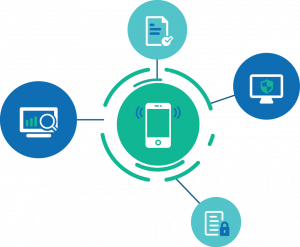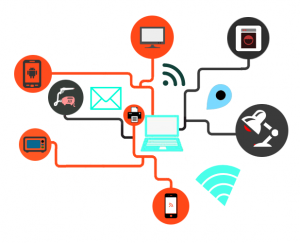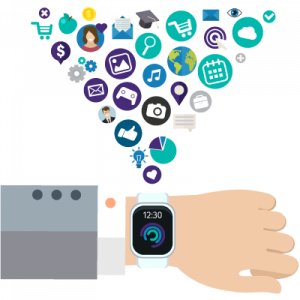Enterprise Mobile App Development – What’s New, What’s Changing and What’s Future

With more than 2 billion smartphone users as well as 27.5 billion mobile applications downloaded, mobile development is amongst the most actively growing and innovative sector. The mobile app market is dominated by Social Media (Facebook, YouTube, Twitter, Instagram), Google Apps (Maps, Search, Gmail) and Gaming Apps (Candy Crush, PUBG).
Giants, such as Bank of America, Amazon, and Walmart are using mobile apps for direct marketing, branding, improving customer engagement, etc. Small and medium-sized businesses are also indulging in the mobile trend. After all, an effective mobile strategy consists of more than a mobile-friendly website.
Therefore, mobile app development is steered by advancement in the technology that requires App Development Companies to have an outlook for the upcoming years. We have listed some of the mobile app development trends below.
Integration of Motion and Location Sensor
Every smartphone has location sensors embedded, which use several positioning methods to offer multiple intricacies of location data. This feature can prove to be highly valuable when it comes to providing vital contextual services and information. Motion sensing applications are popularly used in anti-theft, security, games, and power-saving. Location sensing is useful is games, vehicle navigation, geotagging, fitness apps, and games. These apps use Wi-fi, geomagnetic, imaging, and ultrasonic beacons. Mobile applications and precise indoor location sensing will pave the way for new era of extremely personalized information and services.
Enterprise Mobile Management EMM or enterprise mobile management is a notion encompassing processes, technology, and people that leverage the potentials of mobile computing for the purpose of streamlining the business. The key dimensions of EMM are application management, financial management, and security.
EMM or enterprise mobile management is a notion encompassing processes, technology, and people that leverage the potentials of mobile computing for the purpose of streamlining the business. The key dimensions of EMM are application management, financial management, and security.
It includes mobile app management, application wrapping and containerization, mobile device management, and enterprise sharing and synchronization. In the coming years, these tools will certainly evolve develop in scope, and ultimately address many prominent mobile management needs across various popular Operating Systems (OS) on tablets, smartphones, and PCs.
Devices Connected with Smartphones and IoT IoT or Internet of Things has seen significant growth over the years. It is estimated that more than 26 billion connected devices including , controllable power sockets, sports equipment, domestic appliances, toys, LED light bulbs, medical devices, etc. will be used in 2020.
IoT or Internet of Things has seen significant growth over the years. It is estimated that more than 26 billion connected devices including , controllable power sockets, sports equipment, domestic appliances, toys, LED light bulbs, medical devices, etc. will be used in 2020.
These domestic devices become an aspect of IoT and communicate via through their integration with an app, which can be installed in smartphone, tablet or both. Bascially, tablets and smartphones act like remote controls that monitor and display information, ordering replacement consumables, updating object firmware, paying for subscription services, etc.
Popular examples of such home devices are Alexa, Siri, Google Home, etc. The scope of IoT and connected devices is only growing and it is well on its way to revolutionize the way we interact with the machines.
Related Article – Scope of Enterprise Mobility Solutions
Smart Devices It is a type of electronic device that can be worn as an accessory, implanted in its user’s body, embedded in clothing, or tattooed on skin. These hands-free gadgets powered by microprocessors and upgraded with the ability to receive and send data via the internet possess highly practical uses.
It is a type of electronic device that can be worn as an accessory, implanted in its user’s body, embedded in clothing, or tattooed on skin. These hands-free gadgets powered by microprocessors and upgraded with the ability to receive and send data via the internet possess highly practical uses.
This offers app developers, vendors, and accessory makers new opportunities and ways to receive more personal information about their users. Wearable devices also enable the development of wider range of services and products in areas like fitness, hobbies, healthcare, sport, and fashion.
Some examples include – smartwatches, on-body healthcare sensors, virtual reality sets, smart jewelry, and a range of sensors embedded in shoes and clothes. Therefore, wearable devices connected to smartphones will impact the next generation of strategies regarding mobile app development.
Application Performance Management Essentially there are two factors that determine the efficiency of a mobile application – its diversity and the non-deterministic nature of mobile networks. However, over the years, mobile metrics along with monitoring tools known as APM or Application Performance Management, have significantly improved this process.
Essentially there are two factors that determine the efficiency of a mobile application – its diversity and the non-deterministic nature of mobile networks. However, over the years, mobile metrics along with monitoring tools known as APM or Application Performance Management, have significantly improved this process.
APM is capable of assessing the application behavior, delivering data about which OS’s and devices are integrated in the app, and analyzing user behavior to identify which application features are being used the most.
The sphere of mobile application and enterprise infrastructure is increasingly inclining towards cloud, resulting in challenges for APM tools provide performance benefits against systems through digital perimeters.
Enterprise App Development Companies need powerful and effective tools that can constantly assess the efficiency of the resources utilized by applications, compare the information with valuable consumer insights, and lastly match the app’s performance with the processes of business.
The Growing Popularity of M-Commerce Several analysts believe that consumers will adapt to m-commerce increasingly. The rising popularity of Google Wallet and Amazon Pay will facilitate purchasing utilizing mobile phones instead of credit and debit cards.
Several analysts believe that consumers will adapt to m-commerce increasingly. The rising popularity of Google Wallet and Amazon Pay will facilitate purchasing utilizing mobile phones instead of credit and debit cards.
This will prompt developers to create a mobile app, which can process transactions without needing physical credit/debit cards and cash. Couple with wearables, which can carry out payments, m-commerce will acquire a different shape.
Apart from predictive analytics and data collection, wearables will play an important part in the future of customer loyalty and mobile payments.
Related Article – Digital Transformation Technologies that will dominate Enterprises
Taking Mobile UX and UI a Notch Higher When it comes to rendering excellent user experience seamless display and engaging data become paramount factors. Companies including Instagram, Wunderlist, and Pinterest owe their success to their interactive interfaces and intuitive designs that have helped them pique the attention of their audience and keep them engaged.
When it comes to rendering excellent user experience seamless display and engaging data become paramount factors. Companies including Instagram, Wunderlist, and Pinterest owe their success to their interactive interfaces and intuitive designs that have helped them pique the attention of their audience and keep them engaged.
Designers are constantly working of developing apps that can effectively cater to the various mobile challenges especially with regards to interruptions and attentions. Technological penetration has grown to a notable rate and apps should take full benefits of this growth and work towards building innovative features like circular design patterns, interactive content layers, and manipulations of content. Such features form an augmented reality by letting the users interact with app’s content in further detail.
The leading customer apps are setting great standards for IT design, and all firms need to master new skills as well as work with new partners in order to meet increasing user expectations.
Conclusion
It is impossible to deny that mobile apps have become a deep-rooted part of the digital ecosystem. So, the skills needed in creating consumer applications are in heavier demand than ever currently, forcing businesses to consider mobility seriously.
Because the scope of mobile application usage is growing, it is advisable for businesses to closely follow the newer trends in order to align their mobile app development strategies. This will prevent businesses from becoming obsolete and ultimately lose their market.





One thought on “Enterprise Mobile App Development – What’s New, What’s Changing and What’s Future”
Development of Mobile App plays an important part in smart devices.
Good Work! I like to read this blog.